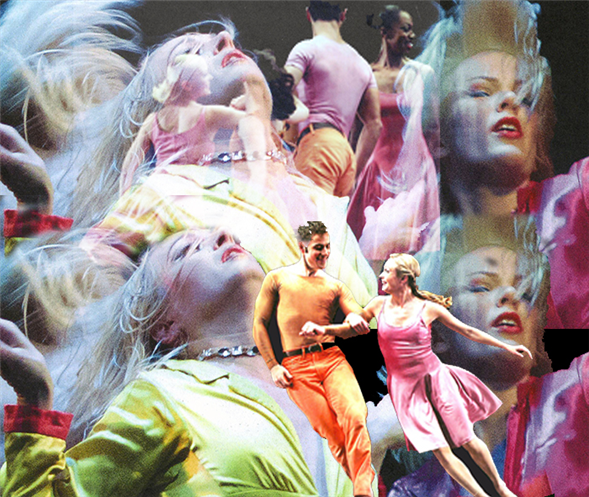As Paul Taylor's esteemed dance company returns to Lincoln Center for its
annual three-week season, performing now through March 29, the repertory will feature the usual assortment of vintage Taylor pieces alongside two anticipated premieres. For all that's familiar, however, much has changed since this time last year. The company not only bears a new name---
Paul Taylor's American Modern Dance---but also welcomes the return of live musical accompaniment.
Last year, as the company marked its 60th anniversary, the plan for PTAMD was announced and swiftly put in motion. Taylor wanted to expand the repertory beyond his own works, masterful and varied as they are, and the new name reflects that broadening scope.
Speaking to
The New York Times, he said, "I want to bring back great works of American modern dance that have been done in the past, so that today's audiences can see them. And I want to encourage future choreographers of modern dance."
There was considerable curiosity about which outside works the company would bring into its repertory, and this season's two non-Taylor pieces are interesting choices for multiple reasons. The first contemporary choreographer whose work will be showcased is Shen Wei, whose
Rite of Spring will be performed by his own company, Shen Wei Dance Arts, on four programs. Shen sets his expansive work to the two-piano version of Stravinsky's score, as did Paul Taylor in his innovative 1980 interpretation.
True to his intention to honor significant modern-dance works from the past that have not been on view in recent years, Taylor has also selected
Passacaglia and
Fugue in C Minor, a monumental 1938 piece by Doris Humphrey. Its Bach score will be performed live by organist Kent Tritle.
Because her choreography has rarely been performed in recent decades, Humphrey's name is less than familiar. To anyone who follows and studies dance, however, she looms large. An exact contemporary of Martha Graham's, Humphrey (1895 – 1958) was among the influential founding figures of American modern dance. From the late 1920s on, she created dances ranging from lyrical early movement studies to grandly structured ensemble statements, often tinged with allusions to social and political issues of the times.
Initially, Humphrey shared a company with another early modern dance pioneer, Charles Wiedman, and it was under the auspices of the Humphrey-Weidman company that
Passacaglia had its premiere at the 1938 Bennington Dance Festival.
Performed both on and in front of a tiered set of boxes assembled into platforms, the work is considered one of Humphrey's finest, penetrating the richness and sophisticated structure of the Bach score and finding within it something ennobling and aspirational.
Sixteen members of the Limón Dance Company will perform it on four PTAMD programs, giving the work its first professional New York showing since 1978, the last time the Limón company revived it.
José Limón, a major choreographer, was Humphrey's protégé and the central dancer in many of her works. She was also his artistic advisor when he formed his company in 1946, and her works were always part of its repertory. They have surfaced infrequently during recent Limón seasons, but are sometimes staged for university dance programs.
"Doris has certainly not gotten her due." says Carla Maxwell, artistic director of (and former dancer with) the Limón company. She was "thrilled" when the Taylor company approached her about including
Passacaglia in this first phase of its new initiative.
Meanwhile, Taylor had his own connection to Humphrey. In 1952, he arrived at the American Dance Festival in New London, Connecticut, the outgrowth of the Bennington Festival. A modern dance newbie, about to transfer to Juilliard after attending Syracuse University on a swimming scholarship, he took Humphrey's composition classes that summer. He also set foot on stage as a dancer for the first time, performing small roles in two of her dances. (His description of his stage debut in his autobiography is priceless.)
Maxwell recalls the spirit of cross-pollination in New London: "I remember Paul coming in several times when José had stage rehearsals. He would just sit and watch. It was a time of sharing. Everybody came and watched everybody."
{Image2}
"I think that what's wonderful about the choice of
Passacaglia is that it's something that's really coming from Paul's personal history," says Carolyn Adams, a former leading Taylor dancer who is part of the advisory committee for PTAMD.
Passacaglia was fortunately recorded in
Labanotation during the 1950s, while Humphrey was teaching at Juilliard, and Jennifer Scanlon, a former Limón dancer, is staging this revival from that notation.
It should be particularly intriguing to see
Passacaglia during a season when four of Taylor's superb dances set to Bach scores are also in the repertory. They will all benefit from live performances by the Orchestra of St. Luke's, conducted by Donald York.
As PTAMD launches, it aims to branch out in several directions, such as commissioning new dances by outside choreographers to be performed by the company members. This should reveal new aspects of these formidable performers, as well as reshape the company's profile to some degree. And Taylor continues to create regularly; he has two new works on tap in the coming weeks.
"I'm excited about this new initiative because it is really Paul Taylor making connections to his career and his work, and I think that's what fascinated him," says Adams. "This is something that Paul has envisioned as a process of transition and transformation of the company."
---
Susan Reiter is a writer based in New York City
Photos by Paul B. Goode
